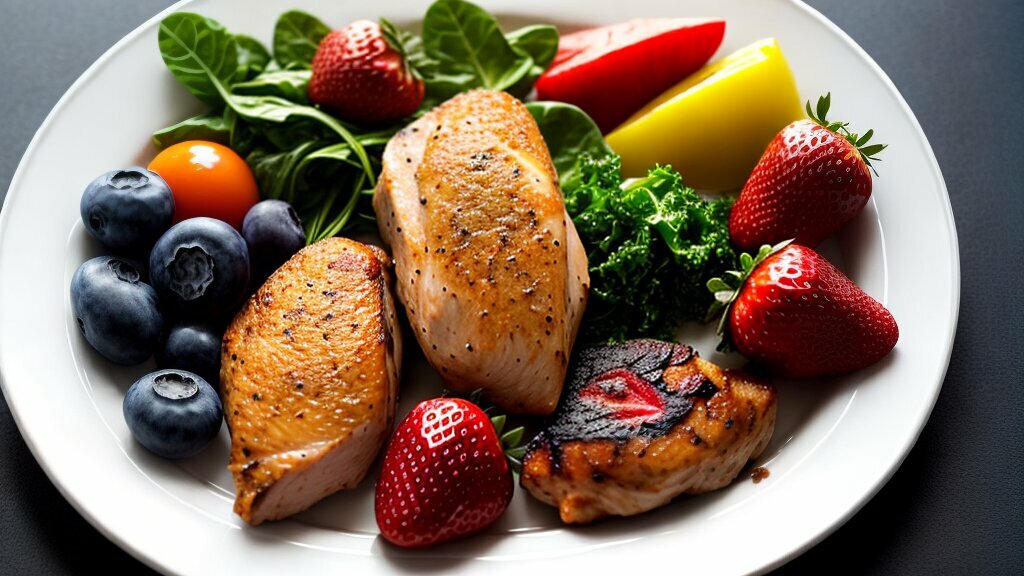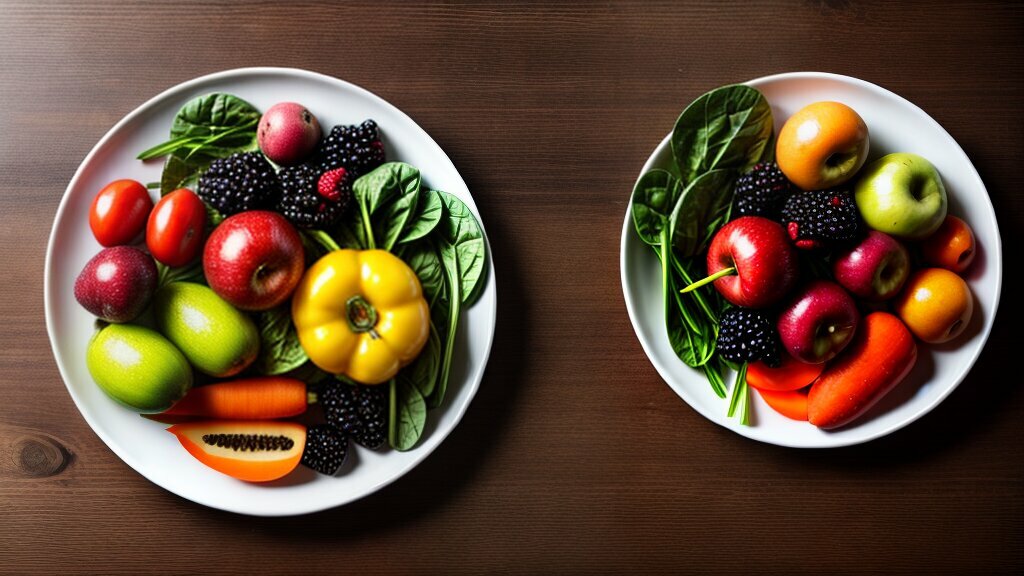Welcome to the ultimate guide on achieving a balanced diet in Australia. You already know that nutrition plays a vital role in maintaining overall health and wellbeing. While it may seem overwhelming to navigate the countless dietary recommendations and fads out there, we’ve got you covered with practical, science-based tips that are easy to implement into your daily routine. Whether you’re looking to shed some extra kilos or simply want to feel your best, mastering your nutrition starts with a balanced diet.
Key Takeaways
- A balanced diet is essential for optimal health and wellbeing in Australia.
- Maintaining a balanced diet requires consuming essential nutrients through healthy eating habits.
- Portion control, meal prepping, and mindful eating are all effective strategies for achieving a balanced diet.
- Following the food pyramid can guide you towards nutritious meal plans.
Importance of a Balanced Diet
Following a balanced diet is essential for maintaining a healthy lifestyle. Incorporating healthy eating habits into your daily routine not only helps in maintaining a healthy weight but also provides the essential nutrients that your body needs to function efficiently. Consuming a variety of foods from different food groups ensures that your body gets all the nutrients it requires.
A balanced diet consists of carbohydrates, proteins, healthy fats, vitamins, and minerals that are all necessary for the body. Carbohydrates are the primary source of energy for the body, proteins are crucial for building and repairing tissues, and healthy fats assist in maintaining healthy skin. Adequate consumption of vitamins and minerals help in maintaining a robust immune system and prevent the body from various diseases.
Healthy eating habits can be developed by focusing on creating a well-rounded meal plan that consists of all the essential nutrients. Incorporating fruits, vegetables, whole grains, and lean protein sources such as chicken, fish, and tofu into your diet is a great starting point. It is also important to limit the intake of saturated fats and processed foods, which contribute to various health issues such as heart disease, diabetes, and obesity.
By incorporating a balanced diet, you not only improve your physical health but also your mental health. Research indicates that individuals who consume a balanced diet report lower levels of anxiety and stress. Thus, a balanced diet is an effective way of improving your overall health and wellbeing.

Understanding Portion Control
Portion control plays a crucial role in maintaining a balanced diet. It involves limiting the amount of food you eat to a reasonable and appropriate size, ultimately helping you manage your weight and reduce the risk of chronic diseases.
One effective way to practice portion control is by using smaller plates, bowls, and cups. This way, you can still enjoy your favourite foods without overeating. Additionally, it is recommended to use measuring cups and spoons to control the amount of food you consume.
| Food Group | Serving Size |
|---|---|
| Vegetables | 1 cup raw or cooked vegetables |
| Fruits | 1 medium-sized fruit or 1/2 cup chopped fruits |
| Grains | 1 slice of bread or 1/2 cup cooked rice or pasta |
| Protein | 3 ounces of meat, poultry, fish, or tofu |
| Dairy | 1 cup of milk or yogurt |
A general guide to portion control is the ‘Plate Method’. It suggests that you fill half your plate with non-starchy vegetables, one-quarter with lean protein, and one-quarter with whole grains.

Practicing portion control promotes healthy eating habits and assists with weight management. By being mindful of the amount of food you consume, you can enjoy a wide range of foods while maintaining a balanced diet.
Benefits of Meal Prepping
Meal prepping can be a powerful tool to support a balanced diet and promote healthier eating habits. By planning and preparing your meals in advance, you can ensure that you are consuming nutritious foods that align with your dietary goals. Here are some of the benefits of meal prepping:
Nutritious Meal Plans
When you meal prep, you have complete control over the ingredients and portions that go into each meal. This means you can ensure that you are consuming all the essential nutrients your body needs to function at its best. You can also tailor your meal plans to support particular health goals, such as weight loss, muscle gain or improved energy levels.
Saves Time and Money
Meal prepping can save you time and money in the long run, as you won’t have to worry about preparing meals every day or buying expensive takeout or fast food. You can also take advantage of sales and deals at the grocery store, as you’ll be buying ingredients in bulk. By cooking meals in large batches, you can also save on cooking time and energy bills.
Reduces Food Waste
Meal prepping can also help reduce food waste, as you’ll be using up all the ingredients you buy and minimizing the risk of spoilage. By planning your meals in advance, you can also ensure that you’re using all the ingredients you buy and not leaving anything to go to waste.

Meal prepping may take some extra effort at first, but it can be a game-changing habit for maintaining a balanced diet and overall good health. By investing a little time each week in planning and preparing your meals, you can take control of your nutrition and set yourself up for success.
Healthy Recipes for a Balanced Diet
When it comes to maintaining a balanced diet, incorporating healthy and nutritious meals into your daily routine is key. Here are some delicious and easy-to-make recipes that align with balanced diet tips:
| Recipe | Ingredients | Instructions |
|---|---|---|
| Grilled Chicken and Vegetables | 2 chicken breasts, 2 cups of mixed vegetables (zucchini, bell peppers, and onions), 2 tablespoons of olive oil, salt and pepper to taste | 1. Season the chicken breasts with salt and pepper. 2. Preheat the grill to medium-high heat. 3. Brush the vegetables with olive oil and season with salt and pepper. 4. Grill the chicken for 6-7 minutes on each side until fully cooked. 5. Grill the vegetables for 3-4 minutes on each side until tender. 6. Serve the chicken and vegetables together. |
| Quinoa and Vegetable Stir Fry | 1 cup of quinoa, 2 cups of mixed vegetables (broccoli, carrots, and snap peas), 2 tablespoons of olive oil, 2 cloves of minced garlic, 1 teaspoon of grated ginger, 2 tablespoons of low sodium soy sauce | 1. Cook the quinoa according to package instructions. 2. Heat the olive oil in a large pan over medium-high heat. 3. Add the minced garlic and grated ginger to the pan and sauté for 1-2 minutes. 4. Add the mixed vegetables to the pan and sauté for an additional 3-4 minutes. 5. Add the cooked quinoa to the pan and stir to combine. 6. Add the low sodium soy sauce to the pan and stir to combine. 7. Serve hot. |
| Spinach and Feta Stuffed Chicken | 4 chicken breasts, 4 cups of fresh spinach, 1/2 cup of crumbled feta cheese, 1 teaspoon of garlic powder, 1 teaspoon of onion powder, salt and pepper to taste | 1. Preheat the oven to 375°F. 2. Season the chicken breasts with garlic powder, onion powder, salt, and pepper. 3. Cut a pocket into the side of each chicken breast. 4. In a mixing bowl, combine the fresh spinach and crumbled feta cheese. 5. Stuff each chicken breast with the spinach and feta mixture. 6. Place the stuffed chicken breasts into a baking dish. 7. Bake for 25-30 minutes until fully cooked. 8. Serve hot. |
| Black Bean and Sweet Potato Tacos | 1 can of black beans, 2 sweet potatoes (peeled and diced), 1 tablespoon of olive oil, 1 teaspoon of chili powder, 1/2 teaspoon of cumin, 1 clove of minced garlic, 8 small tortillas, optional toppings: avocado, salsa, cilantro | 1. Preheat the oven to 400°F. 2. In a mixing bowl, combine the diced sweet potatoes, olive oil, chili powder, cumin, minced garlic, salt, and pepper. 3. Spread the sweet potato mixture evenly onto a baking sheet. 4. Bake for 20-25 minutes until the sweet potatoes are tender. 5. Drain and rinse the black beans. 6. Warm the tortillas in the oven or microwave. 7. Assemble the tacos with the black beans, sweet potatoes, and any optional toppings. 8. Serve hot. |
Enjoy these tasty and nutritious meals as part of your balanced diet in Australia. Remember to incorporate a variety of food groups and practice portion control for optimal health.

The Food Pyramid and Balanced Diet
The food pyramid is a valuable tool for maintaining a balanced diet and achieving optimal nutrition. It is a visual representation of the recommended food groups and the proportions in which they should be consumed.
The food pyramid is divided into five main groups: grains, vegetables, fruits, dairy, and protein. Each group provides essential nutrients that are necessary for the body to function properly.
| Food Group | Recommended Servings |
|---|---|
| Grains | 6 servings per day |
| Vegetables | 5 servings per day |
| Fruits | 2 servings per day |
| Dairy | 2-3 servings per day |
| Protein | 2-3 servings per day |
It is important to note that these recommendations are based on a typical adult with a moderate activity level. Your individual needs may vary based on factors such as age, gender, activity level, and health conditions.
Incorporating the recommended servings of each food group into your daily meals can help ensure that you are consuming a balanced diet that meets your nutritional needs. It can also help prevent nutrient deficiencies and reduce the risk of chronic diseases.
To put the food pyramid into practice, aim to include a variety of foods from each group in your daily meals. For example:
- Grains: Whole grain bread, brown rice, oatmeal, quinoa
- Vegetables: Broccoli, spinach, sweet potatoes, carrots
- Fruits: Apples, bananas, berries, oranges
- Dairy: Milk, cheese, yogurt, fortified plant-based milks
- Protein: Chicken, fish, beans, tofu
By following a balanced diet that incorporates the food pyramid, you can improve your overall health and wellbeing.

Mindful Eating for a Balanced Diet
Mindful eating is the practice of paying attention and being fully present while eating. It involves using your senses to fully experience the taste, texture, and smell of food, as well as paying attention to your body’s hunger and fullness signals.
By practicing mindful eating, you can become more aware of your eating habits and make healthier choices. For example, you may notice that you tend to eat when you’re bored or stressed, rather than when you’re actually hungry. By being mindful, you can learn to distinguish between actual hunger and cravings, and make choices that support your balanced diet.
Here are some strategies to help you practice mindful eating:
- Eat slowly and chew your food thoroughly. This will help you fully experience the flavors and textures of your food, and give your brain time to register when you’re feeling full.
- Avoid distractions while eating, such as watching TV or scrolling on your phone. Instead, focus on the act of eating and the experience of enjoying your food.
- Take a few deep breaths before starting your meal to help you relax and be present in the moment.
- Tune in to your body’s hunger and fullness signals. Stop eating when you feel full, even if there is still food on your plate.
- Practice gratitude for your food and the nourishment it provides.
By incorporating mindfulness into your eating habits, you can not only improve your physical health, but also your mental and emotional well-being.

Conclusion
Congratulations on taking the first step towards mastering your nutrition in Australia! By following the balanced diet tips outlined in this article, you are well on your way to achieving optimal health and wellness.
Remember, maintaining a balanced diet is crucial for healthy eating habits and providing your body with the essential nutrients it needs. Portion control and meal prepping can assist with weight management and ensure you are consuming nutritious meals regularly.
You can also explore a variety of healthy recipes that align with a balanced diet, suitable for different dietary preferences or restrictions. Additionally, incorporating the recommended food groups into your daily meals, as outlined in the food pyramid, can help you achieve optimal nutrition.
Practicing mindful eating habits is also a powerful tool in maintaining a balanced diet. By being present and fully engaged in the act of eating, you can tune in to your body’s needs and make conscious choices about what and how much you consume.
Remember to make small and sustainable changes to your diet and lifestyle, as consistency is key for achieving long-term results. By following these balanced diet tips, you can prioritize your health and wellness, and lead a happier, healthier life in Australia.
FAQ
Q: What is a balanced diet?
A: A balanced diet refers to a way of eating that includes a variety of foods from all the essential food groups in the right proportions. It ensures that your body receives the necessary nutrients for optimal health.
Q: Why is a balanced diet important?
A: A balanced diet is important because it provides your body with the nutrients it needs to function properly. It promotes overall health, helps maintain a healthy weight, and reduces the risk of chronic diseases.
Q: How can portion control help maintain a balanced diet?
A: Portion control involves eating the right amount of food to meet your body’s needs. It helps prevent overeating and promotes a balanced intake of nutrients, contributing to a healthier diet and weight management.
Q: What are the benefits of meal prepping for a balanced diet?
A: Meal prepping allows you to plan your meals in advance and ensure they are nutritious and balanced. It saves time, helps control portion sizes, and encourages healthier eating habits by reducing reliance on unhealthy convenience foods.
Q: Can you provide some healthy recipes for a balanced diet?
A: Yes, we offer a variety of healthy recipes that align with a balanced diet. Whether you have dietary preferences or restrictions, you can find suitable options that will provide the necessary nutrients for a balanced and nutritious meal.
Q: How does the food pyramid support a balanced diet?
A: The food pyramid is a visual guide that shows the recommended proportions of each food group for a balanced diet. It helps ensure that you include a variety of nutrients from different food groups in your daily meals for optimal nutrition.
Q: What is mindful eating and how does it relate to a balanced diet?
A: Mindful eating is the practice of being fully present and aware of your eating experience. It involves paying attention to your body’s hunger and fullness cues, as well as savoring and enjoying each bite. Mindful eating promotes a balanced diet by helping you make more conscious and nutritious food choices.
